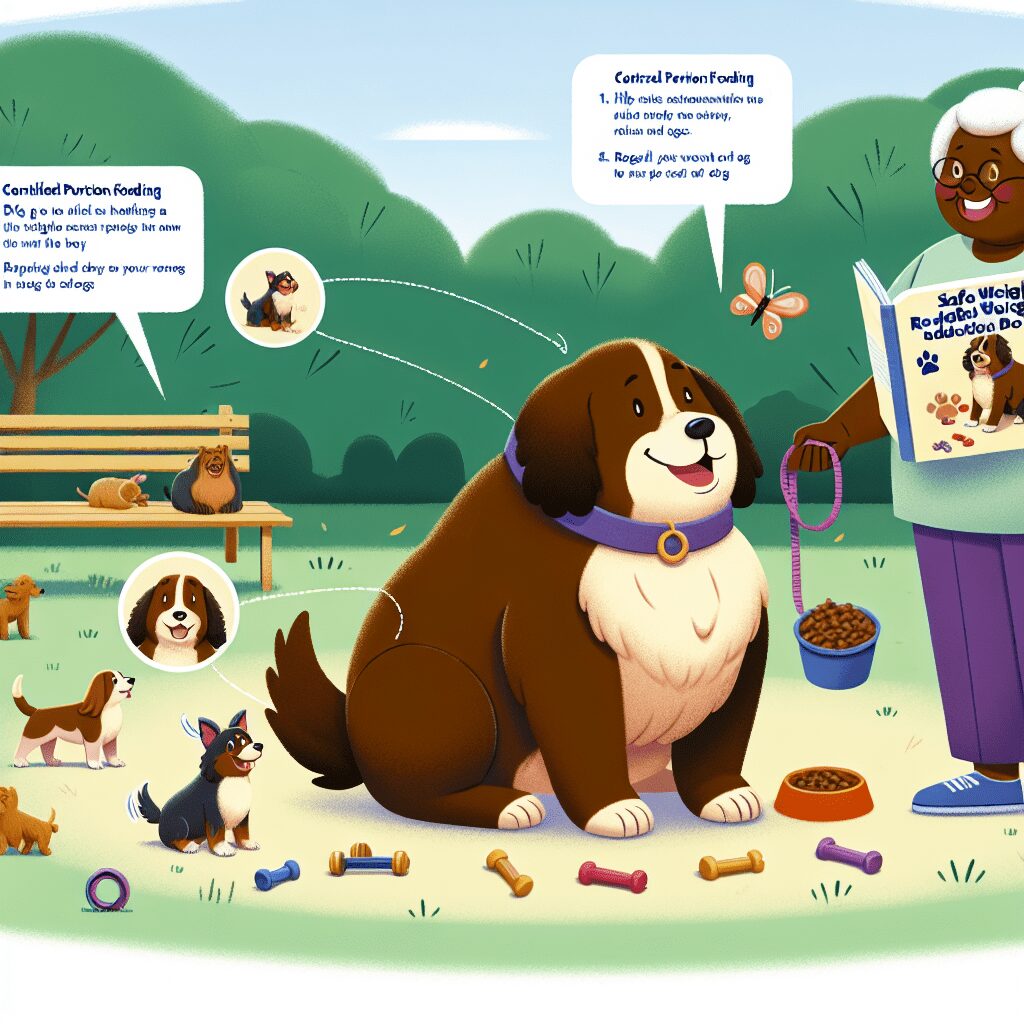A Healthier Wag: Effective Strategies for Safe Weight Loss in Dogs
As devoted dog lovers, we strive to give our furry friends the best of everything—love, care, tasty treats, and ample playtime. However, even with the best intentions, some dogs can struggle with weight management, which is crucial for their overall health. According to the Association for Pet Obesity Prevention, as of recent data, over half of the dogs in the United States are considered overweight or obese. This statistic is not just alarming; it’s a call to action for anyone who loves a pup as much as we do. Join me as we explore effective strategies for helping your beloved canine get back into tip-top shape, wagging their tail with confidence!
Chapter 1: Understanding Canine Obesity
Before diving into practical strategies, let’s clarify why canine obesity is a pressing issue. Just like in humans, excess weight in dogs can lead to a multitude of health problems, including diabetes, joint issues, heart disease, and even some forms of cancer. Each extra pound can add a significant strain on a dog’s body, not to mention affect their quality of life. For instance, how many times have we seen our beloved pups struggle to keep up during playtime or appear winded after a short walk? Understanding the seriousness of canine obesity is the first step towards a healthier dog.
Chapter 2: Assessing Your Dog’s Weight
Identifying whether your dog is at a healthy weight can be done through various methods. A simple way to assess this is by using the body condition score (BCS) system, which typically ranges from 1 to 9, with 4 to 5 being optimal. To evaluate your dog’s BCS, observe their ribcage. You should be able to feel their ribs with a gentle touch but not see them prominently. Additionally, your dog should have a defined waist when viewed from above, and their abdomen should tuck up when viewed from the side. If you’re unsure, a trip to the vet can provide clarity—I recommend it as a part of your dog’s health routine!
Chapter 3: Nutritional Knowledge Is Power
What goes into our dogs’ bowls every day has a direct impact on their weight. It is vital to understand that not all dog foods are created equal. High-calorie pet foods can often be misleading; the packaging may boast of "complete nutrition," while the calorie count skyrockets. Opt for high-quality food formulated for your dog’s specific age, breed, and activity level. Additionally, it’s wise to consult your veterinarian to determine the appropriate portion size. Just because a rascal gives you those puppy-dog eyes doesn’t mean they should score extra treats!
Chapter 4: Creating a Balanced Diet Plan
Once you understand your dog’s caloric needs, it’s time to create a balanced meal plan. Ideal dog diets include proteins, carbohydrates, fats, vitamins, and minerals. To help with weight loss, consider these approaches:
- Portion Control: Measure your dog’s food instead of free-feeding.
- Healthy Alternatives: Substitute high-calorie treats with low-calorie options, such as carrots, apples, or commercial low-calorie dog treats.
- Introduce Fruits and Vegetables: Many canines enjoy apples, blueberries, green beans, and more. These snacks are low in calories and high in fiber.
Cooking for your pooch can also lead to healthier options, but always do your research to ensure you’re using dog-safe ingredients.
Chapter 5: Implementing an Exercise Routine
Now that your dog’s diet is under control, let’s talk about the fun part—exercise! Just like humans, our furry friends require regular physical activity to maintain a healthy weight. Aim for at least 30 minutes of exercise per day—this can be broken down into manageable chunks. Here are some suggestions to incorporate exercise into your dog’s daily routine:
- Daily Walks: Simple yet effective; vary the pace and route to keep things interesting.
- Playtime: Engage in games like fetch or tug-of-war which can also build your bond.
- Dog Parks: Let your dog socialize while getting their exercise fix.
Incorporating these activities into your daily life not only helps your pup shed those extra pounds but strengthens your relationship.
Chapter 6: Staying Consistent
Consistency is crucial in the journey towards a healthier weight for your dog. Set measurable goals and keep track of progress—create a chart to document your dog’s weight weekly or bi-weekly. Celebrate small milestones! Is your dog finally fitting into that cute sweater? Did they run a lap around the park without tiring out? Those are achievements worth acknowledging!
It’s essential to remain patient during this process. Weight loss is not a quick fix but a gradual shift to a healthier lifestyle for your furry friend.
Chapter 7: Overcoming Challenges
During your weight loss journey, you may encounter challenges. Dogs can be uncooperative, stubborn, or just plain sneaky when it comes to sneaking extra treats! In such cases, it’s important to stay calm and find solutions that work for both of you.
- Involve the Family: Ensure that everyone in the household understands that no extra treats should be given. Consistency is key.
- Consult a Professional: If you’re uncertain about the best approach or if your dog has underlying health issues, seek help from a veterinary nutritionist or a weight management program.
Above all, stay positive and celebrate every victory, no matter how small it may seem!
Chapter 8: The Joy of a Healthy Dog
A hefty dog may not just be a sign of overeating; it’s reflection of a lifestyle in need of some tweaks. However, the journey to a healthier dog is rewarding! With sustained effort towards improved nutrition and an active lifestyle, you’ll notice changes in your pup’s energy levels and overall happiness. You’ll see them prancing with joy during walks, chasing after balls with enthusiasm, and enjoying their day-to-day life in ways you might not have seen before. Your canine companion will thank you with every wag of their tail!
Conclusion
In conclusion, the path toward achieving and maintaining a healthy weight for your dog is a collaborative effort that requires dedication, love, and some sensible strategies. By understanding the causes and consequences of canine obesity, assessing your dog’s weight, ensuring a balanced diet, implementing an exercise routine, and remaining consistent through challenges, you can help turn your dog’s life around. It’s not just about the numbers on the scale; it’s about improving their quality of life, ensuring they remain by your side for many years to come, and witnessing the joy in their wagging tails!
FAQs
1. How fast should my dog lose weight?
Weight loss should be gradual for dogs. A general guideline is 1% to 2% of their body weight per week. Sudden weight loss can be harmful. Always consult your veterinarian for personalized advice.
2. Can I give my dog human food?
Some human foods are safe and healthy for dogs, while others can be toxic (like grapes or chocolate). If you want to include human food, do so in moderation and research thoroughly. Always check with your vet first!
3. How can I keep my dog motivated during exercise?
Make exercise fun! Use toys, involve playdates with other dogs, or take them to different locations for variety. Keeping activities fresh keeps dogs engaged and excited.
4. Is it okay to feed my dog a weight-loss diet food?
Weight-loss diet foods can be beneficial for dogs struggling with obesity. However, consult with your veterinarian first to ensure it meets your dog’s nutritional requirements.
5. Are there medical conditions that could cause my dog to gain weight?
Yes, certain medical conditions (like hypothyroidism) can lead to weight gain in dogs. If you suspect a medical issue, consult your veterinarian for a proper diagnosis.
Unlock the Secrets to a Well-Behaved Dog! 🐾 Tired of your pup’s bad habits? Discover how to transform your unruly dog into a loving companion with our FREE Dog Training Mini Course! Learn essential commands, potty training tips, and effective techniques to eliminate unwanted behaviors in just days. Don’t miss out—sign up now and start your journey to a happier, obedient dog! Join Here! (https://bit.ly/3RJak0a)
Instantly Access Your Free Children’s Books Here! (https://payhip.com/BlueCherryStore) – Disclaimer: As an Amazon Associate, I earn from qualifying purchases, I may earn a commission from qualifying purchases as an affiliate. Please note that I only recommend products I believe will provide value to my readers. (M)









